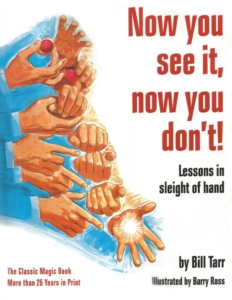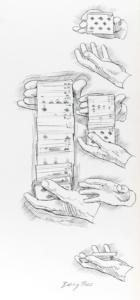How to Learn Magic
A Testimonial for a Classic Beginner’s Magic Book

Practicing the Waterfall Flourish
Many people ask how they can learn magic. As my blog attests, finding a mentor or others willing to help you along the way is obviously the best path. But how many people are lucky to have access to great magicians?
Today many would turn to YouTube or commercially produced videos designed to be sold to wannabe magicians. While the video media does offer some advantages when it comes to learning magic, they also suffer from several limitations. First, being modern, one is not afforded access to critical concepts and important pieces that were popular prior to the advent of video tape. Second, the inexpensive nature of video allows people to carelessly share any little idea they might have, free from any sort of consideration of actual value.
Back in the day, when it was expensive to produce books, material was more carefully vetted before it was foisted upon magic students, and the actual creators of the ideas were more likely to be the ones publishing as opposed to whoever could click “upload” the fastest. But worst of all, video instruction discourages active engagement in the learning process. When one reads a book one is required to fill in the gaps of handling, they hear the suggested “patter” in their own voice, and they end up projecting themselves into the work during the process of education. With videos, it often becomes a case of “monkey see – monkey do.” Video has created an army of interchangeable magicians, with interchangeable personalities, performing interchangeable tricks – all repeating the same flaws and weaknesses they were taught.
 Books are a much better means of learning magic. The nonlinear nature of the book allows one to flip back and forth as well as pause and consider what they are reading. Yes, sometimes it is challenging to visualize the moves being explained, but that only encourages further thought and can lead to new discoveries as the student explores the material.
Books are a much better means of learning magic. The nonlinear nature of the book allows one to flip back and forth as well as pause and consider what they are reading. Yes, sometimes it is challenging to visualize the moves being explained, but that only encourages further thought and can lead to new discoveries as the student explores the material.
And, like video, not all books are created equal. Writing is difficult and some magic books are just really hard to read. I remember my first advanced book on card tricks. Unlike those intended for beginners, this book would tell you what to do, but not always how to do it. Terms like “Faro shuffle,” “Elmsley count,” and “Straddle grip” were tossed around without any explanation. Thankfully, I had a pair of books in my library that became my magic “Rosetta Stone.”
 Now You See It, Now You Don’t is a pair of books written by magician/artist Bill Tarr and illustrated by Barry Ross. The explanations were short and well-conceived. The illustrations managed to convey the moves IN ACTION. To this day I recommend both volumes as essential texts for newly interested magicians. In these books you will learn the basics of sleight of hand with cards, coins, dice, thimbles, and much more. Though beginner’s books, that doesn’t mean the material is easy. It took several months before I could perform the pressure fan, or spring the cards from one hand to the other. Heck, it was several YEARS before I figured out how to perform the classic “Waterfall Flourish” reliably.
Now You See It, Now You Don’t is a pair of books written by magician/artist Bill Tarr and illustrated by Barry Ross. The explanations were short and well-conceived. The illustrations managed to convey the moves IN ACTION. To this day I recommend both volumes as essential texts for newly interested magicians. In these books you will learn the basics of sleight of hand with cards, coins, dice, thimbles, and much more. Though beginner’s books, that doesn’t mean the material is easy. It took several months before I could perform the pressure fan, or spring the cards from one hand to the other. Heck, it was several YEARS before I figured out how to perform the classic “Waterfall Flourish” reliably.
Recently, Ross – the talented artist responsible for the illustrations – discovered a cache of the original drawings and has made them available on his website www.magicartbarryross.com.
If you are looking to learn a little sleight of hand magic, I cannot recommend these books more highly. There is a wide range of material from nearly self-working, to knuckle busters.
Brad Henderson has been teaching magic for over 30 years. He is considered to be one of the deepest thinkers in magic, and has written for every major magic publication in the last half of the 20th century.
To purchase Now You See It, Now You Don’t: Amazon
To view and purchase some of Barry Ross’s amazing illustrations visit. www.magicartbarryross.com




Leave a Reply
Want to join the discussion?Feel free to contribute!